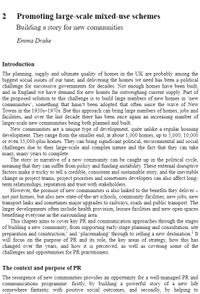Emma Drake (Henbe) is the author of LARGE SCALE MIXED-USE SCHEMES: Building a story for new communities
LARGE SCALE MIXED-USE SCHEMES
The Chapter
This chapter explains the challenges and barriers for PR practitioners working on the development of new communities – from planning and construction, to promoting a new destination. It covers the strategic approach required and the political, environmental and economic issues that can impact on development. It emphasises the importance of a strong narrative, well-crafted key messages and stakeholder engagement. The chapter also includes best practice guidance, case studies and practical tips on managing relationships and issues, and monitoring and evaluating a communications programme.
The Author
Emma is an independent communications consultant and Chartered Public Relations Practitioner with 20 years’ experience in the communications industry. Emma helps organisations in both the public and private built environment sector, predominantly in housing and large scale development. Emma was one of the first CIPR practitioners to obtain both of the Post Graduate Diploma and subsequently the Crisis Communications Diploma. She is volunteer director of a local community charity and also a member of the Chartered Institute of Marketing.
An interview with the author
What is you background and your experience of promoting large scale communities?
My background is 20 years in corporate communications, public relations and marketing. More than 10 years have been within the built environment supporting long-term large-scale major infrastructure projects such as Nottingham tram and town centre regeneration, working for the government’s housing body Homes England leading the strategic land portfolio communications and working with large-scale developments such as Northstowe New Town, as well as private/public sector developments such as Eddington in Cambridge and innovative companies in housing such as rent-to-own financial services and products, commercial architecture practices and modular housebuilders. I’ve worked in strategic communications for most of that time having been one of the first graduates of the CIPR post-grad Diploma in Public Relations and subsequently topped this up with the Crisis Communication post-grad Diploma as well. My work has been nominated for 3 CIPR and CIM awards and in January 2000 I was also named one of 60 ‘most influential women in planning’ for media and comms by Planning Magazine.
What / who motivates you?
I like to work on topics that have depth, that excite me and I can get passionate about. Housing and technology and finance services/products have made up all of my PR career experience so I like to get under the skin of things and really get to know the subject matter I am working with. Topics that relate to society or are fundamental to our existence also are so important which is why housing, construction and advances in these areas are all a passion of mine.
What led to you to getting involved in Promoting Property?
I got involved in writing this book as I have a heap of knowledge in this particular subject area and it is very niche, I have discovered. Having been embedded in the development process for many years on projects such as Northstowe Town, you also get to see it from all angles and, therefore, the communication challenges that can come up and also learn what you would do differently if presented the same challenge again as these projects happen over many, many years and approaches and technologies change and keeping up to date with that can help projects succeed. I also think that housing and where we live are hugely important topics and form the very fabric of our society. Too often the communication aspect of building new places is not recognised as a critical part of the ‘placemaking’ process and is seen as something that happens occasionally, gets ‘plugged in’ or when something goes wrong or there’s something to sell. Wrong. To be effective, it needs to be embedded as part of the strategic overview and, ideally, from the very start. If as much money was invested in a manufactured project that was new to the market, there would be a whole team of communication and marketing professionals behind it helping the research and development team reach their goals. Creating, developing and selling places is not different in that respect and requires the same investment in communication and PR.
How does the property industry benefit from PR?
There are several factors related to how the property industry can benefit from having a good PR team board. The industry has a backdrop of built-in reputational challenges related to sustainability of construction and gender balance as well as it’s a complex subject matter for members of the public, in particular, to get their heads around so the communication aspect is interesting and challenging. It’s also highly competitive so you need to be creative and good with core subjects such as audience segmentation, stakeholder engagement tactics and key message development to help your content reach the right people at the right time and in the right way.
What changes do you expect to see in the next decade?
The property industry is still behind the curve in terms of how it networks and communicates and this will have to change in light of events in 2020 with Covid1-19 forcing people to get to grips with online services, events and activities. Those of us skilled in these areas will hopefully survive but traditional PRs will find this a challenging time moving forward unless they upskill and diversify their skills and also take a strong position with clients and internal stakeholders in terms of how, when and what to communicate to effectively engage with customers and other stakeholders. There has never been a better time for PR professionals to come into their own and advise management and the board on how to communicate and organisations will be looking to their teams and advisors on how to take things forward on development sites as well.
How important is creativity in what you do?
Creativity plays a key role but it isn’t always that obvious when working on long-term strategic development projects. However, creativity comes in many forms as this is as much about thinking creatively about how you will approach a task, such as an issue on-site, as well as the content that is being produced to engage stakeholders and customers to see them interested in the product/development over a very long period. Development items can benefit from creative thinkers such as PR professionals to help solve these challenges and issues in an effective and empathetic way as well as developing great content.
What are the key learning points that are communicated in your chapter?
Through this chapter readers will learn from someone who has first-hand experience, read about examples of best practice at the time of writing, learn what to look out for in terms of the key challenges and how to overcome them, as well as how taking a strategic long-term view can pay dividends including setting out how to measure the effectiveness of your activities in this context. It will also provide some tools and ‘top tips’ on how to deal with specific issues and opportunities as well as demonstrate these in practice through working examples. It will help you whether you are new to the sector, or in a communications role in this area as well as act as an essential guide to sense-check your own strategy if you are an established PR practitioner, development director or master developer working on large-scale housing-led developments.

